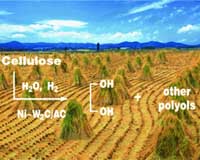 |
Knoxville TN (SPX) Jun 18, 2010 Some bacteria destroy oil. Might those bacteria lead oil companies to change their methods of harvesting the energy of the oil while at the same time reducing the carbon dioxide that burning oil and gasoline discharges into the atmosphere? Steve Larter thinks that may be possible. Larter, professor of geoscience and holder of the Canada Research Chair in Petroleum Geology at the University of Calgary, was the keynote speaker for the 2010 Goldschmidt Conference hosted by the University of Tennessee, Knoxville, and Oak Ridge National Laboratory. In his presentation, "Can Studies of Petroleum Biodegradation Help Fossil Fuel Carbon Management," Larter discussed microbes in the environment and their role in breaking down oil and generating natural gas. Petroleum biodegradation takes place in environments where petroleum is near ground level, actually seeping from the surface, or in oil-spill situations. Bacteria, yeasts, molds and certain fungi naturally break down petroleum in these environments. Larter discussed how these microbes take the byproducts of decomposition, such as carbon dioxide, and produce methane (natural gas) and hydrogen, less polluting fuels. Larter also examined the feasibility of capturing carbon dioxide and pumping it and special bacteria underground into alkaline rock formations where the carbon dioxide, the most abundant greenhouse gas, will be converted into natural gas, a valuable source of energy. The Goldschmidt Conference is an annual meeting sponsored by a number of international geochemical societies. The conference is named for Victor Goldschmidt (1888-1947), the Swiss-Norwegian scientist who was the father of geochemistry.
Share This Article With Planet Earth
Related Links University of Tennessee at Knoxville Bio Fuel Technology and Application News
 New Microbial Genetic System Dissects Biomass To Biofuel Conversion
New Microbial Genetic System Dissects Biomass To Biofuel ConversionMadison WI (SPX) Jun 17, 2010 A research team at the DOE Great Lakes Bioenergy Research Center (GLBRC) has developed a powerful new tool that promises to unlock the secrets of biomass degradation, a critical step in the development of cost-effective cellulosic biofuels. The details of this method were published online on June 11 in the journal Applied and Environmental Microbiology. Fulfilling the promise of cellulosic ... read more |
|
| The content herein, unless otherwise known to be public domain, are Copyright 1995-2010 - SpaceDaily. AFP and UPI Wire Stories are copyright Agence France-Presse and United Press International. ESA Portal Reports are copyright European Space Agency. All NASA sourced material is public domain. Additional copyrights may apply in whole or part to other bona fide parties. Advertising does not imply endorsement,agreement or approval of any opinions, statements or information provided by SpaceDaily on any Web page published or hosted by SpaceDaily. Privacy Statement |